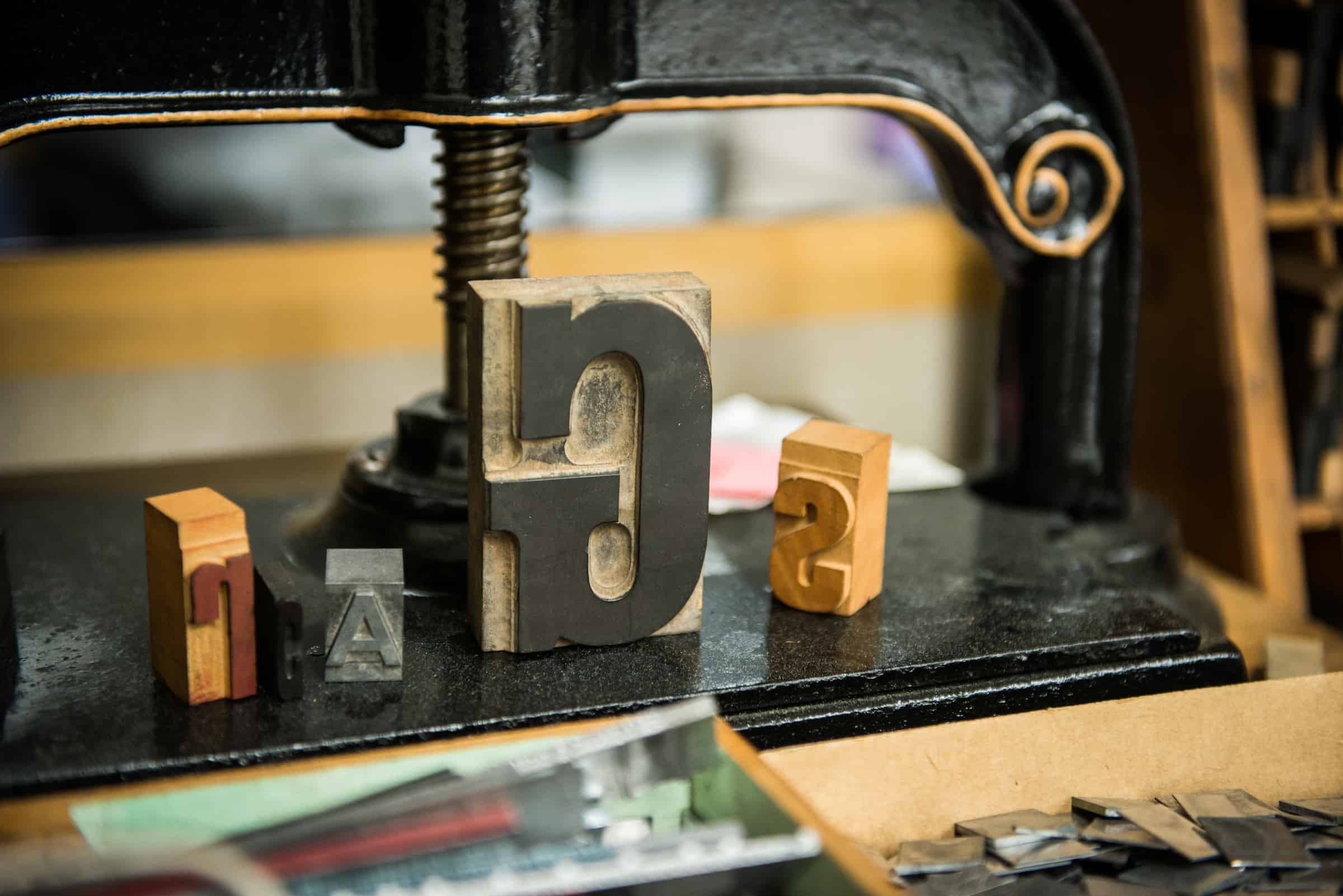Varsity Vignettes: Print Room at Kelly Library from The Varsity on Vimeo.
If you’re buying a bookmark or a Christmas card from St. Michael’s Kelly Library, there’s a good chance that it was lovingly crafted inside its Print Room. St. Michael’s Print Room is one of U of T’s hidden gems: a place to learn about the centuries-old art of printing. The facility is an invaluable resource for undergraduates in St. Michael’s Book and Media Studies program, where students learn about typography, the history of printing and printing processes, how to properly research, evaluate, and handle books, and the on-going evolution of book design.
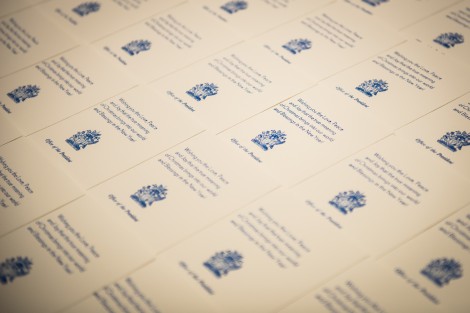
When I first arrive at the Print Room, dozens of Christmas cards are laid out on a metal table. This year, the college has commissioned over 600 cards. In indelible blue ink on the front cover is an image of Jesus and the Virgin Mary, originally designed by famed early twentieth century printer Eric Gill. I ask master printer Imre Rozsa how long a print run like this can take.
“It’s sort of hard to say at first. It depends on the job. For this card, for example, we’re printing on all four sides, and because it’s a large number — we’re printing about 600 cards — it could take about a couple of weeks to do,” he explains.
Rozsa has been master printer at the Print Room for over two years. After completing an internship in printing at Massey College, he learned that a spot had opened up at the Print Room and was “happy to jump to it.” He now manages the Print Room’s many projects and helps train the student volunteers who assist him in the printing process.
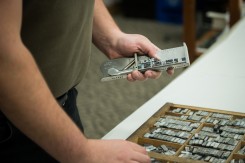 “What we usually do is that, whoever commissions the cards, we would do an initial consultation of what they want or they would say: ‘Please show us a couple of examples.’ We do five or six examples and then we’ll send the proofs off to them. Or in this case,” Rozsa says pointing to the Eric Gill design, “the front cover is a custom-made block, [so] then I would make up the block. I would make a sample print and then send it back and forth. Once that’s done then you can start composing the text.”
“What we usually do is that, whoever commissions the cards, we would do an initial consultation of what they want or they would say: ‘Please show us a couple of examples.’ We do five or six examples and then we’ll send the proofs off to them. Or in this case,” Rozsa says pointing to the Eric Gill design, “the front cover is a custom-made block, [so] then I would make up the block. I would make a sample print and then send it back and forth. Once that’s done then you can start composing the text.”
Composing is one of the most interesting aspects of the whole printing process: moveable type is placed along a composing stick, spelling out the text that is going to be printed. Small metal spacers are placed between the words. It’s a little more involved than simply typing on your keyboard and printing it out later, but the best compositors can place a line of text with an amazing level of speed and efficiency. Once composition is finished, you lock the text into a frame and it’s ready for printing.
The Print Room’s showcase is the CMC Jobber, a fascinating manually-operated press originally used in the 1930s and 1940s.
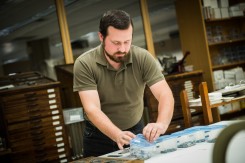 “The way it works is that it has a footpedal, which you pump with one of your legs. It will turn and build up momentum on the large flywheel,” explains Rozsa. “Then that will move all the rollers back and forth from the inking desk onto the form. And when you’re ready to make an impression, you have another lever that you can move forward, and that’ll move the platen [the flatbed that presses the paper to the form] forward two metres and allow it to put the ink on the paper.”
“The way it works is that it has a footpedal, which you pump with one of your legs. It will turn and build up momentum on the large flywheel,” explains Rozsa. “Then that will move all the rollers back and forth from the inking desk onto the form. And when you’re ready to make an impression, you have another lever that you can move forward, and that’ll move the platen [the flatbed that presses the paper to the form] forward two metres and allow it to put the ink on the paper.”
The CMC Jobber — a fairly complex mechanism that requires sufficient practice — can only be used by trained students or under the supervision of the print master. However, there are simpler presses available for general use by those with little or no prior experience.
“We have a press called a linoscribe. It’s a table roller press, it’s very easy to use, very safe, and we usually let people try that. We also have a tabletop version of the CMC Jobber. It’s also very safe,” Rozsa says.
“Often what happens is that a volunteer will come in and Imre does training sessions with them and teaches them how to use different tools and how to use the printing presses,” explains Silvia Vong, an instructor in the Book and Media Studies program. “He has different projects that volunteers work on that allow them to be creative… It’s great to get volunteers in here, getting new ideas.”
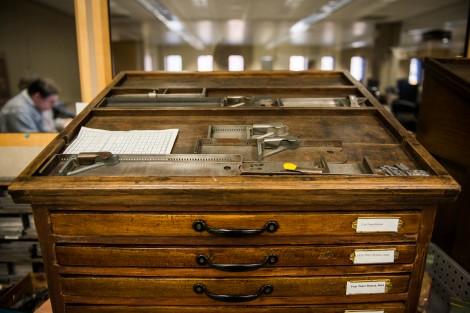
“I really like printing presses. I was really excited when I learned I could work here as a volunteer,” comments Keely Kundell, a third-year Book and Media Studies and English double-major. “I do a little bit of everything. He teaches me how to do it, and then if he’s busy I can do that job. I’ve done composing, I’ve helped make a lot of the cards. I try out the different fonts so that they know what to use when they decide what type of cards they want to use.”
One of the coolest pieces of print technology at St. Michael’s is actually just outside the Print Room. The Landon Press is a fully operational wooden printing press loosely based on a similar press originally designed by Benjamin Franklin. The Landon Press is usually employed for much larger print runs and, according to Rosza, operating it is often a two- to three-person job. After obtaining blueprints based on Franklin’s design from the Smithsonian, Rozsa set to work making the press, a project that took over a year to complete.
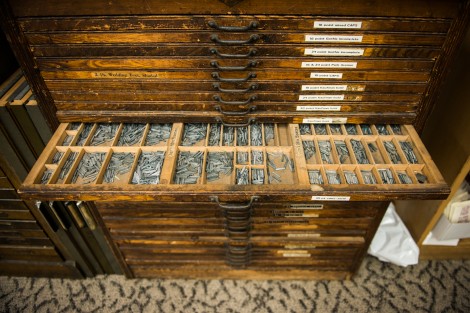
“I was thrilled about building a hand press. Through various fundings I got the go-head to make the press. They requested that it would be something like the Ben Franklin press,” says Rozsa. “However, I used my own artistic licence in designing the press … what I did with the press was beef it up. Originally it was about 2.5 inches on the vertical posts and I wanted to double that. Every part of the press is much thicker, much stronger.”
Rozsa drew on a wide range of wood types in designing the press including elm, oak, maple, walnut, and even year-old maple — the “Canadian flavour for the press.” It was important to use hardwood in the design of the press, and some of the timber was so large that he had to have it cut at a 150-year-old water mill.
It’s quite an impressive piece of technology, especially when Rozsa demonstrates how to use it. There’s a gentle and refined process to making sure all the right elements are in place. This includes inking the form, keeping the paper in place with gauge pins, making sure your platen is centred, and ensuring the frames are properly locked up. Then the printer turns a handle which brings the platen down to make a print. Although it’s complex, with several people helping it takes just 45 seconds per print.
The craft of printing is still alive at Kelly Library, practised by those with a passion for a hands-on approach to art and design. The Print Room is a place for students to explore, learn, and create. That’s the best part: University of Toronto students don’t have to sit and read about printing in textbooks and reading kits. We have a place where we can do it ourselves.

